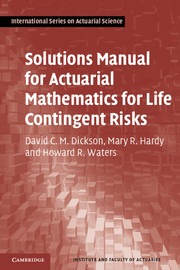Book contents
- Frontmatter
- Contents
- Preface
- Solutions for Chapter 1
- Solutions for Chapter 2
- Solutions for Chapter 3
- Solutions for Chapter 4
- Solutions for Chapter 5
- Solutions for Chapter 6
- Solutions for Chapter 7
- Solutions for Chapter 8
- Solutions for Chapter 9
- Solutions for Chapter 10
- Solutions for Chapter 11
- Solutions for Chapter 12
- Solutions for Chapter 13
- Solutions for Chapter 14
Solutions for Chapter 3
Published online by Cambridge University Press: 05 June 2012
- Frontmatter
- Contents
- Preface
- Solutions for Chapter 1
- Solutions for Chapter 2
- Solutions for Chapter 3
- Solutions for Chapter 4
- Solutions for Chapter 5
- Solutions for Chapter 6
- Solutions for Chapter 7
- Solutions for Chapter 8
- Solutions for Chapter 9
- Solutions for Chapter 10
- Solutions for Chapter 11
- Solutions for Chapter 12
- Solutions for Chapter 13
- Solutions for Chapter 14
Summary
3.1 Figures S3.1, S3.2 and S3.3 are graphs of μx, lx and dx, respectively, as functions of age x up to x = 100. Each graph has been drawn using the values from ELT 15, Males and Females.
(a) The key feature of Figure S3.1 is that the value of μx is very low until around age 55, from where it increases steeply. Numerically, μx is very close to qx provided qx is reasonably small, so that the features in Figure S3.1 are very similar to those shown in Figure 3.1 in AMLCR. The features at younger ages show up much better in Figure 3.1 in AMLCR because the y-axis there is on a logarithmic scale. Note that the near-linearity in Figure 3.1 in AMLCR for ages above 35 is equivalent to the near-exponential growth we observe in Figure S3.1.
(b) The key feature of Figure S3.2 is that, apart from a barely perceptible drop in the first year due to mortality immediately following birth, the graph is more or less constant until around age 55 when it starts to fall at an increasing rate before converging towards zero at very high ages. This reflects the pattern seen in Figure S3.1.
(c) The function dx is the expected number of deaths between exact ages x and x + 1 out of l0 lives aged 0. The relatively high mortality in the first year of life shows clearly in Figure S3.3, as does the increase in the expected number of deaths for males in the late teenage years – the so-called ‘accident hump’.
- Type
- Chapter
- Information
- Publisher: Cambridge University PressPrint publication year: 2012



